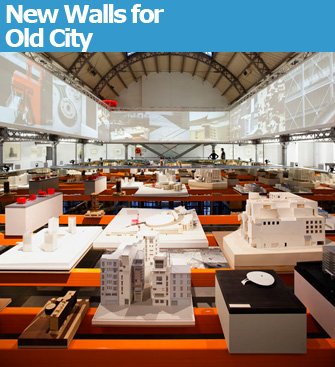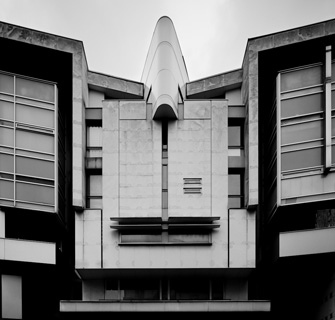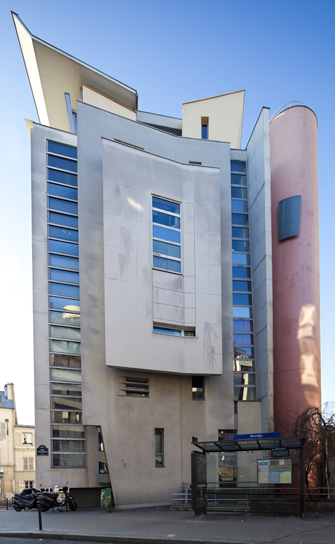 |
|
Models of buildings constructed in Paris over the past five decades. Photo © Vincent Fillon |
The raging debate about Paris’s architectural future (maximum building heights, “Grand Paris,” etc.) has calmed considerably as building funds dry up during these tough …
 |
|
Models of buildings constructed in Paris over the past five decades. Photo © Vincent Fillon |
The raging debate about Paris’s architectural future (maximum building heights, “Grand Paris,” etc.) has calmed considerably as building funds dry up during these tough economic times, so perhaps this is a good moment to take stock of what has been actually been built in the greater Paris area over the past half-century, the goal of the exhibition “Œuvres Construites: 1948-2009” (“Built Projects: 1948-2009”) at the Pavillon d’Arsenal.
The show, co-produced with the Centre Pompidou, has been beautifully staged by architect Philippe Gazeau. Models of 29 of the 58 projects presented seem to float in space, but are actually set on steel beams in the open area between the ground floor and the second level. Visitors look down on the models from above and can see, in the interstices, the people and exhibits on the ground floor. For a close-up look at the models, they can zoom in with one of the 18 Zeiss camcorders attached to the railings around the well; the image each camera is focused on is also projected on overhead screens around the well.
Detailed, easy-to-read information on each model is provided on large plasticized sheets hanging over the edge of the railing. They include a picture of the model to make it easy to spot and a photo of the actual building today, allowing for comparisons between intention and reality. Other projects are presented more traditionally in the surrounding spaces, with models and drawings and some interesting videos of architects being interviewed about or presenting particular projects.
All this makes for an accessible, highly enjoyable exhibition. The projects on display show that while Paris is not exactly a laboratory for radical new architecture, neither is it an architectural museum frozen in the past, as some critics contend. We also learn from this highly variegated selection of buildings that architectural coherence is no longer the norm in Paris.
In addition to a number of very well-known buildings – the Centre Pompidou by Renzo Piano and Richard Rogers, for example, Dominique Perrault’s Bibliothèque National de France and Frank Gehry’s wonderful American Center (now the Cinémathèque Française), which he once likened to “a dancer lifting her tutu” – the show presents some hidden architectural gems that few non-residents ever see, among them architect Massimiliano Fuksas’s Îlot Candie Saint-Bernard (1996), located not far from the center of Paris in the 12th arrondissement but tucked away on residential side streets,
 |
|
Frédéric Borel’s Post Office building on Rue Oberkampf in Paris. Photo © Darren Palmer |
and Christian de Portzamparc’s Les Hautes Formes (1979) housing project in the 13th arrondissement, with its subtle, well-integrated references to medieval architecture in a handsome, complex modern building. I also discovered that Oscar Niemayer of Brasilia fame had designed another building in the Paris area besides his Communist Party Headquarters in the 10th arrondissement: the curved building with a mirrored facade next to the cathedral in Saint Denis.
While some of the texts describing the projects suffer from a sort of boosterism, praising projects that don’t seem to deserve it (it is hard to agree, for example, that the Tour de Montparnasse project is “one of the most surprising successes of contemporary urban planning”), visitors will almost certainly be inspired to visit buildings that they are unfamiliar with. I myself will be taking a closer look at Frédéric Borel’s Post Office building (pictured above) at 113, rue Oberkampf (75011) and his sculptural apartment buildings at 100, boulevard Belleville and 131, rue Pelleport, both in the 20th arrondissement.
 |
|
Apartment building by Frédéric Borel in Paris. Photo © Darren Palmer |
Pavillon de l’Arsenal: 21, boulevard Morland, 75004 Paris. Métro: Sully-Morland or Bastille. Tel.: 01 42 76 33 97. Open Tuesday-Saturday, 10:30am-6:30pm; Sunday, 11am-7pm. Admission: free. Guided tours with curators: January 23, February 6 and March 13 at 3pm (to reserve: 01 42 76 33 91 or infopa@pavillon-arsenal.com). Through March 28. www.pavillon-arsenal.com
Buy related books and films from the Paris Update store.
More reviews of Paris art shows.
Reader Reaction
Click here to respond to this article (your response may be published on this page and is subject to editing).
© 2010 Paris Update
Favorite